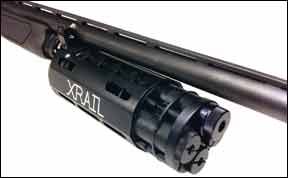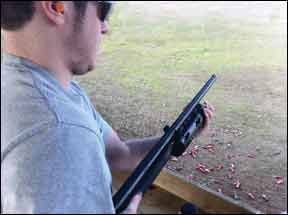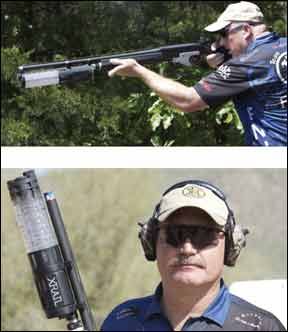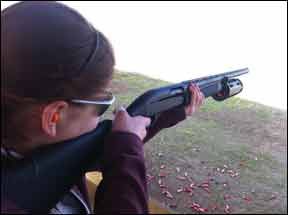Shooters into 3-Gun competition are driving a lot of innovation in firearms and performance accessories, arguably benefitting the shotgun segment the most. Practical rifles and pistols already have plenty of development to improve sights, speed, and capacity, and many of those improvements — beveled mag wells, lightened hammers, expanded magazine capacities, various optics, lightweight materials — have found their way into mainstream guns at nearly all pricepoints. Shotgun development has lagged the other two gun types, but scatterguns are now the beneficiaries of drop-in triggers, rail systems, high-viz sights, collapsible replacement buttstocks, and other refinements, but capacity has been an ongoing restriction. Shotshells are big in both profile and weight, so they take up a lot of space. To carry a stage count of 20 to 23 rounds — nearly a box! — means pushing in big, ungainly magazines on Saigas, ripping strip loaders into under-barrel extension tubes, or carrying extra shells on a belt and feeding them on the fly with advanced reloading techniques.

288
Roth Concept Innovations (RCI) claims to solve this 3-Gun shotgun puzzle with its Xtreme Roth Auto Indexing Loader Systems, or XRAILS, which are shotgun magazine extensions that carry up to 23 rounds and do not alter the original gun (not totally true, as we note below). The XRAIL (hereafter Xrail) is also touted as being suitable for military and law-enforcement use, and it offers the additional benefit of transferring to more than one shotgun. The Xrail accepts rounds fed through the gun’s magazine tube, the same way the shooter normally loads his gun. Once the main tube is full (6 rounds in the gun’s mag tube and 2 rounds in the Xrail), the shooter rotates the Xrail to the first auxiliary tube and loads 2, rotates to the second aux tube and loads 2, and rotates the unit and loads 2 in the third aux tube for a total of 14. Then the rounds empty in reverse order of how they were loaded. Once the shooter is working on the main tube supply (6+2), he can top it off and continue using the extended round count in the main tube by reloading normally.
In Detail
The Xrails are hard-coated black-anodized aluminum-and-stainless-steel rotating drums that attach to the existing magazine tube on a pump or autoloading shotgun. Inside the metal shell are four black-nylon or clear polycarbonate tubes that hold the shells in a 12-3-6-9 o’clock pattern. The Compact unit we tested increases the shotgun’s magazine count to either 13 or 14 shells, depending on the gun. Unloaded, the Compact unit weighed 2 pounds even and measured 10 inches in length from the front of the forend to the end of the main tube. It was 3 inches wide (maximum diameter) and stood 4.1 inches tall, including the arms that lock onto the barrel. The Full version weighs 2.3 pounds empty and holds either 21 or 22 rounds.

288
We attached our Compact unit to a new Remington 11-87 Sportsman Synthetic 12 gauge No. 29879 with a 28-inch barrel. The gun alone weighed 8.1 pounds. The empty Xrail weighed 2 pounds, making the unloaded and already muzzle heavy package a hefty 10.1 pounds. Fourteen Winchester Super-X 12-gauge Game Loads (2.75 inch, 3.25 dr. eq., 1-ounce shotcharge of No. 8 lead pellets) added 1.25 pounds for a grand total of 11.4 pounds. (The Xrail accepts only 2.75-inch shells, and not all of those, as we note below.)
Our Compact unit came from Brownells, which carries a full line of the Xrails. The Remington systems attach to Remington 870, 11-87, 1100, and Versa Max 12-gauge shotguns. The 14-round Compact Remington 11-87 version (#100-006-576) we tested runs $649. The Full-size Remington 11-87 Xrail (#100-006-577) goes for $699. RCI recommends a minimum barrel length of 26 inches for the Full version and a minimum barrel length of 22 inches for the Compact. If you use shorter barrels than recommended, some of the Xrail will stick out past the muzzle and gather carbon build-up on the housing.
Compact and Full versions are also available for Benelli SBE, SBE2, M1, M2, and M2 shotguns (minimum barrel lengths of 20/24 inches, respectively); FN SLPs (minimum barrel lengths 22/26 inches), which include an RCI Replacement Magazine Tube; Mossberg 930 Series shotguns with traditional-style barrels only (minimum barrel lengths 22/26 inches); and Winchester SX3 shotguns with 3-inch chambers (minimum barrel lengths 22/26 inches). All the RCI products come with a 1-year limited warranty.
There are also legal considerations that come with owning Xrails, which to its credit, RCI does detail. The company website, www.XRAILbyRCI.com, clearly states where they will not ship the Xrail systems. So if you’re in a magazine-restricted state, check your local regulations before you go any further.
Installation
On the surface, the Xrail system seems easy to install — just change a couple of fittings and springs, snug the unit onto the barrel, and give it a literal whirl. But we encountered a host of issues that RCI doesn’t cover adequately in its printed, PDF, and video instructions, our team said. In particular, some shotguns must be physically — and substantially — modified to accept the Xrail; some shotshells don’t work well in the unit; and fittings work loose unless they’re Loctited in place.
The Xrail system we got from Brownells came with a replacement magazine follower, a spring, and a connecting system for the 11-87 shotgun. The first hiccup was that the follower in the package (an orange anodized-aluminum cup) was different than the follower shown in the stapled-together printed directions that came with the unit. So we downloaded the PDF User Manual, which clearly showed the new follower.
RCI’s website says, “If your gun is new and never had a magazine extension, it may have tabs in the mag tube that will need to be removed.” This is all technically correct, and we understand RCI’s stance that it cannot anticipate all installation problems on a given gun. But in our view, RCI makes these pricey units to fit certain platforms, and the company should inform the potential customer up front that certain guns — such as our Remington 11-87 — pose much bigger installation problems than others.
The Remington 11-87 does indeed have two tabs, or crimps, that push into the interior of the tube near the front. RCI’s FAQs say the tabs must be removed, and the site offers, “Either take the gun to your favorite gunsmith, or you can do it yourself if you are comfortable. Just drill them [the tabs] out and sand the tube down so there are no rough spots. Those would have to be removed if you were to put any magazine extension tube on the gun (not just the XRAIL System), as the ammo and follower will not pass by them.”
The tabs can be drilled out and then smoothed inside the tube wall, but that leaves two holes in the mag tube. We used a Dremel tool and ground down the two tabs until they felt flush, then sanded and polished the tube walls until we had a smooth, flat surface the follower would pass by. That took the better part of two hours because it required several function checks with the Xrail in place to ensure the follower would scoot up and down the mag tube without sticking. If we had known (as Gun Tests readers now do) that the 11-87 required this time-consuming step, we’d have chosen a different platform. Or, we would have ordered a Brownells Magazine Tube Dent Raiser (#080-870-206, $75) at the same time to knock the tabs out in about 5 minutes. Also, you should note that the FNH SLP Xrail kit comes with a replacement magazine tube, which of course requires removing the existing magazine tube. We didn’t perform this operation, but we read that removing the original tube requires a blowtorch. Caveat emptor.
Our testers also noted the video instructions didn’t show the entire process of removing the existing barrel nut, spring, and follower as part of the process. Our view is that on a complicated piece like the Xrail, RCI shouldn’t assume anything and should painstakingly start the video with putting on safety glasses and running a clearance check, then showing each step (and every step) in loving detail. The PDF instructions were much better at this, we noted.
With the tabs out, we were ready to perform a near-final install. To do that, we started by separating the barrel nut from the connector, then threaded the connector into the Xrail’s base plate and hand-tightened it. We flipped the gun upside down and slid the straddle jaw clamps over the barrel. Then we slid the Xrail down the barrel toward the barrel nut and mated the Xrail’s connector to the barrel nut and hand-tightened it.
Then, using a 3/32 Allen bit (not provided, but should be, we thought) in a screwdriver handle, we tightened the top set screws so the barrel was centered over the system, torqueing them to 16 pound inches, per the directions. RCI recommends applying a blue thread-locking compound at this point. We didn’t do this during our install because we wanted to see how much the unit loosened in regular use, but we’d recommend low-strength purple #222 Loctite to start. It retains assembled screws tightly, but it still allows occasional turning or adjustment. It works especially well on fine-threaded aluminum and very small diameter screws. Screws coated with #222 can be removed with regular hand tools and do not need to be recoated after adjustments have been made.

288
Next, we tightened the lower set screws until we bottomed them out on the lower portion of the jaw clamps and checked the gap between the barrel and the top of the Xrail. An even gap was what we looked for to ensure the system wasn’t improperly tightened. The set screws which support the unit dig into the barrel metal. To minimize cosmetic damage, you can put shims between the set screws and the barrel.
Then we unscrewed the main tube cover and slid in the orange replacement follower and main tube spring (having removed the original parts when we ground down the tabs).
Function Test
With the Xrail in place, we loaded the 11-87 and magazine and cycled the action on the shotgun to see if the Xrail worked. Unfortunately, this can’t be done solely with dummy rounds, because the system is sensitive to different ammos. We had eight ammo selections on hand. The 12-gauge rounds from Remington were Gun Club Target Load GC1218 (1185 fps, 2.75 dr. eq., 1 ounce of No. 8s), ShurShot Target Load RT128 (1200 fps, 3 dr. eq., 1.125 ounce of No. 8s), ShurShot Long Range R12LR4, (1330 fps, 1.25 ounce of No. 4s), and Premier Nitro Sporting Clays STS12NSC7 (1300 fps, 1.125 ounce of No. 7.5s). From Winchester, we had Super-X Heavy Game Loads XU12H8 (3.75 dr. eq., 1.125 ounce of No. 8s), Super-X Game Loads XU128 (3.25 dr. eq., 1.5 ounce of No. 8s), AA Super Sport Sporting Clays (1300 fps, 1.125 ounce of No. 7.5s), and Xpert Hi-Velocity Steel Shot WEX12H2 (1400 fps, 1.125 ounce of No. 2s).
With the firing pin removed from the bolt, we attempted to fully load the Xrail, then chamber and hand-cycle the rounds. We started with the Game Club rounds, but could not get the Xrail to turn and allow us to fill the auxiliary tubes. We shifted to the ShurShot Target load and had the same problem initially.
We reread the documentation and saw that overtightening the jaw screws could cause the housing to bind and prevent the drum from turning. So we backed down the screw tightness and tried to load the ShurShots. After eight rounds were in, we turned the Xrail, and it released. We loaded it to capacity in the 8/2/2/2 sequence, and hand-cycled the ShurShots. The remaining six ammos loaded and hand-cycled with no further problems. All in, the installation and hand-function check took four hours.
We then trekked to the range and set up at the shotgun line, where the Xrail got lots of attention from the ROs and from other shooters. We began shooting the 11-87 and the Gun Club ammo, and we were pleased to see the Xrail accept the light round for loading. But we had fired only two shots when the action locked closed and a shell partially exited the magazine, freezing the whole dang gun closed. We couldn’t open the action by hand, and had to resort to scraping the bolt handle against the shooting bench to rip it open.
We re-oiled the shotgun action and switched to the slightly more powerful ShurShot Target load and fired only eight (the capacity of the main tube) shots, then hand-worked the bolt a few dozen times, then reloaded the main tube again. After five sets of that process, we loaded 14 rounds into the entire Xrail, and the gun and magazine functioned perfectly. So we believe the problems with the Gun Club ammo were probably related to the gun itself.

288
We worked through the remaining loads fairly cleanly, experiencing only an occasional sticking of the follower being captured in the Xrail. This was likely due to the loosening of the connector/barrel nut joint and/or the loosening of the jaw-clamp screws, which we had to tighten periodically. As we noted before, the directions specifically said the threads would need to be locked with a sealer to prevent the pieces from vibrating apart, but we didn’t take that step because we wanted to see how badly vibration affected the unit. Pretty badly, we’d say.
Using the Xrail
Our three test shooters fired slightly more than 700 rounds through the Xrail. Many of the early malfunctions could easily be the fault of the gun, the gun/ammo mix, or the gun/ammo/Xrail combination. We can’t separate the problems and lay them at the feet of the magazine; there are simply too many variables to blame the Xrail alone. But the unaltered 11-87 wouldn’t cycle the Gun Club ammo either, so we didn’t blame the device.
Benelli shooters might wonder if their inertia-drive shotguns will work with the Xrails. The short answer is a qualified yes. RCI notes that during extensive tests of the Benelli M1, M2, SBE1, and SBE2 shotguns with both the Full and Compact Versions of the Xrails, each combination of shotgun and Xrail performed best when using higher-dram ammunition and with proper lubrication. The higher-dram ammunitions offset the dampening of the inertia drive caused by the additional weight. The company recommends that when used with stock Benelli shotguns, the Full Xrail should be loaded with 3.5-dram (1350 fps) 1.25-ounce shotshells or greater. The Compact systems on Benellis should use 3.25-dram (1250-1300 fps) powder equivalents and shotloads of 1.25 ounces or more. Also, we found the 11-87 benefitted from the Benelli lubrication regimen of spraying a light oil on the bolt-carrier rails and dry-cycling the action before loading and firing. We likewise resprayed oil in the action and mag tube every 100 rounds.
Unquestionably, the Xrail Compact changed the handling characteristics of the 11-87, though there were positives and negatives. One negative in particular — almost a disqualification from our female tester — was the Xrail boosting the overall weight from 8.1 to 11.4 pounds. She complained that horsing the front end around was very tiring, and, in fact, she usually had to shoot 14 shots in two strings.
All three testers said the effort needed to rotate the magazine was substantial. We chose to load only 14 rounds because we closed the bolt on an empty chamber, making the gun safe for the loading sequence. That involved shoving eight shells into the bottom of the gun to fill the main tube, then pulling the gun rearward to reach the index pin on the top right side of the unit. The pin has to be pulled out slightly to allow the assembly to rotate the first time. It’s a failsafe device to ensure the shooter loads the main tube full with 8 shells before trying to fill the other three tubes with two shells apiece. In the main tube, the shells compress the orange follower and magazine spring deeply into the Xrail’s body, and if enough shells aren’t loaded, there’s no gap between shells to allow the magazine to turn — instead, the spring bridges the gap between the Xrail and the tube, and if the Xrail turns, it can damage the spring.
If you pull the indexing spring and rotate the Xrail without ammo in the main tube, the tube housing will try to unwind. The main tube spring will stop the tube housing from unwinding to its relaxed position. Doing this can damage the spring if you reset the housing to its original “set position” and the spring ends up hooked around the spring retainer peg that protrudes from the bottom of the inner tube housing. If the spring is hooked on the retainer peg, the system will not allow shells to be loaded. If you pull the pin and rotate the tube housing in the loading direction without the main tube being loaded past the connection point, you will wind the main tube spring around the central axis of the inner tube housing, possibly causing the spring to be permanently damaged.
Once eight shells are loaded in the main tube, the shooter pulls the index pin, releasing the Xrail to turn counter-clockwise. Cranking the Xrail 90 degrees involves enough handstrength effort that our female shooter couldn’t load the magazine completely. Our male shooters eventually learned to grasp the front of the Xrail, release the index pin, and twist the Xrail counterclockwise simultaneous with twisting the gun clockwise to snap the next tube in line.
When we shot crossing clay rabbits with a fully loaded Xrail, it was pretty nice to track the first rolling clay and pop it, but stopping the gun’s front end and getting on a rabbit going the other way took strong obliques and a wide base, and we were usually late. Also, transitions between widely-spaced targets are slower because there’s more mass to push.
Shooting static targets, though, is a dream. Just start and keep shooting. The sensation of needing to reload after seven or eight shells is strong, but you’ve still got six or seven left. The shooter can hear the Xrail spinning new tubes into place, and if you’re shooting a Full version, you and your fans can see the tubes spin as the Xrail dumps shells into the gun. The extra weight also dampens muzzle rise significantly, so it’s easier to lock onto the gun and ride it through recoil to the next target.
Our Team Said: Action shooters who want one of the highest-capacity shotguns on the range should consider the Xrail. If you have the time and motivation to tune the unit, it will allow you to shoot many shotgun stages without a reload. The fixed-position self-defense shooter equipped with a shotgun and an Xrail gains a huge firepower advantage against nearly any foe — it shoots both slugs and shot interchangeably, but the tradeoff is sluggishness. For hunters, the Xrail Compact is too heavy and the weight distribution too front-biased for field use, in our opinion, even if you could find a game species legal to hunt with it.





























XRail for mossberg 930 spx
XRail for the Remington 1100 please!!!
Great overview! Thanks!
Dont even think about it. Video tells it all. https://youtu.be/3-CIxcgzi_I?si=VTPW5quLodjTaIpG